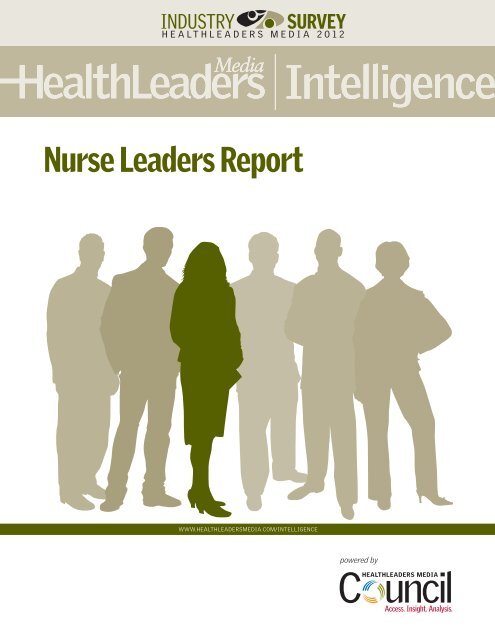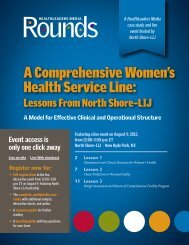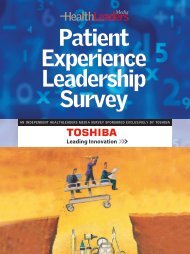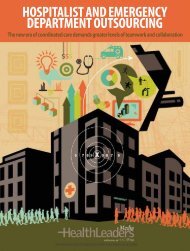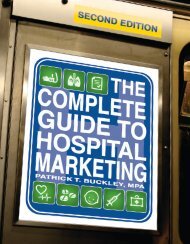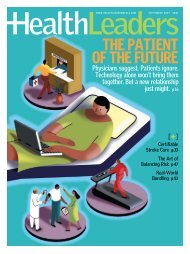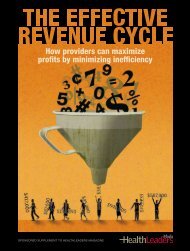Nurse Leaders report - HealthLeaders Media
Nurse Leaders report - HealthLeaders Media
Nurse Leaders report - HealthLeaders Media
You also want an ePaper? Increase the reach of your titles
YUMPU automatically turns print PDFs into web optimized ePapers that Google loves.
INDUSTRY<br />
SURVEY<br />
HEALTHLEADERS MEDIA 2012<br />
<strong>Nurse</strong> <strong>Leaders</strong> <strong>report</strong><br />
WWW.HeALTHLeAderSMedIA.COM/INTeLLIGeNCe<br />
powered by<br />
C<br />
HEALTHLEADERS<br />
uncil<br />
MEDIA<br />
Access. Insight. Analysis.
healthleaders media industry survey 2012 <strong>Nurse</strong> <strong>Leaders</strong> <strong>report</strong> page 2<br />
About This Survey<br />
The Health<strong>Leaders</strong> <strong>Media</strong> Industry Survey 2012 was conducted by the Health<strong>Leaders</strong><br />
<strong>Media</strong> Intelligence Unit. In October 2011, an online survey was sent to the Health<strong>Leaders</strong><br />
<strong>Media</strong> Council and select members of the Health<strong>Leaders</strong> <strong>Media</strong> audience.<br />
The study is based on four concurrent surveys: Senior <strong>Leaders</strong>, Finance <strong>Leaders</strong>,<br />
Physician <strong>Leaders</strong>, and <strong>Nurse</strong> <strong>Leaders</strong>. In addition, data has been extracted and<br />
<strong>report</strong>s created based on CEO title, community and rural status, and service lines.<br />
The surveys included some common questions for all respondents and some questions<br />
directed at leaders in specific segments.<br />
A total of 1,070 completed surveys are included in the overall survey analysis. The<br />
margin of error for a sample size of 1,070 is +/- 3.0 percentage points at the 95% confidence<br />
interval. A detailed breakout of completed surveys by <strong>report</strong> is listed below.<br />
Percentage totals do not always add up to 100% due to rounding.<br />
Report<br />
Number of<br />
Completed<br />
Surveys<br />
Sampling Variance<br />
at the 95%<br />
Confidence Interval<br />
Overall Cross-Sector Report 1,070 +/- 3.0%<br />
Senior <strong>Leaders</strong> Report 468 +/- 4.5%<br />
Finance <strong>Leaders</strong> Report 117 +/- 9.1%<br />
Physician <strong>Leaders</strong> Report 136 +/- 8.4%<br />
<strong>Nurse</strong> <strong>Leaders</strong> Report 296 +/- 5.7%<br />
CEO Report 117 +/- 9.1%<br />
Community & Rural <strong>Leaders</strong> Report 468 +/- 4.5%<br />
Service Lines Report 1,017 +/- 3.1%<br />
WWW.HEALTHLEADERSMEDIA.COM/INTELLIGENCE | ©2012 Health<strong>Leaders</strong> <strong>Media</strong>, a division of HCPro, Inc.
Join an exclusive<br />
community of<br />
industry leaders.<br />
The Health<strong>Leaders</strong> <strong>Media</strong> Council.<br />
• Have a voice<br />
• Be the first to access industry<br />
intelligence<br />
• Use peer insight to benchmark your<br />
organization<br />
• Shape the future of the industry<br />
Join today at<br />
Health<strong>Leaders</strong><strong>Media</strong>Council.com<br />
C<br />
HEALTHLEADERS<br />
uncil<br />
MEDIA<br />
Access. Insight. Analysis.
healthleaders media industry survey 2012 <strong>Nurse</strong> <strong>Leaders</strong> <strong>report</strong> page 3<br />
Addressing the<br />
Disrespect Disconnect<br />
Of<br />
<strong>Nurse</strong><br />
<strong>Leaders</strong><br />
Surveyed<br />
Smooth working relationships among nurses and physicians are<br />
seen as vital to increasing value in healthcare delivery, but there<br />
is a vast divide in the perception of how doctors treat nurses, the<br />
Health<strong>Leaders</strong> <strong>Media</strong> Industry Survey 2012 reveals.<br />
23<br />
percent<br />
Rate their<br />
organization’s nursing<br />
staff as very strong<br />
13<br />
percent<br />
Rate their<br />
organization’s physician<br />
staff as very strong<br />
41<br />
percent<br />
Say nursing staff salary<br />
increases are at least a<br />
year away<br />
49<br />
percent<br />
Say their hospital is<br />
moving toward more<br />
advanced-level nurses<br />
in clinical operations<br />
When asked how pervasive is physician<br />
abuse or disrespect of nurses, there was a<br />
clear disconnect between the two. While<br />
42% of nurse leaders said it was common,<br />
only 13% of physician leaders said it was<br />
common. Likewise, 58% of nurse leaders<br />
said it was uncommon, while 88% of<br />
physician leaders said it was uncommon.<br />
Pam Kadlick, RN, BS, MBA, MSN,<br />
vice president of patient care and chief<br />
nursing officer for 112-staffed-bed Mercy<br />
St. Anne Hospital in Toledo, OH, says she<br />
is surprised at what she cited as a high<br />
level of disrespect <strong>report</strong>ed by the nurse<br />
leaders.<br />
The findings illustrate fundamental<br />
“ineffective communication or having<br />
different expectations” among the two<br />
groups, with physicians sometimes<br />
having a misperception of nurses’ roles,<br />
and nurses in conflict with physicians<br />
over the “misunderstanding of what<br />
needs to be done at a given time,” Kadlick<br />
says. She acknowledges that such<br />
communication problems could manifest<br />
themselves when a physician “cuts off” a<br />
nurse’s suggestion or comment.<br />
“I do believe nurses and physicians are<br />
on two different pages when it comes to<br />
communication,” Kadlick adds. “Time<br />
is a commodity for physicians today.<br />
When they present to do rounds, they<br />
want to have pertinent data given to<br />
them. <strong>Nurse</strong>s have a tendency to give<br />
a very detailed <strong>report</strong>, more than what<br />
a physician may want to hear; hence,<br />
the physician may interrupt, seem to be<br />
abrupt, even rude at times.”<br />
When confronted as being rude or<br />
disrespectful, a physician often would<br />
be “truly taken aback, as they do not see<br />
it this way,” Kadlick says. Referring to<br />
<strong>report</strong>s of alleged abuse, Kadlick says she<br />
believes that “while there are validated<br />
incidents of true disrespect for nurses by<br />
physicians, these incidents are minimal.”<br />
As health systems improve care<br />
coordination and increase the roles of<br />
nurse navigators, Kadlick says she expects<br />
the communication between nurses and<br />
doctors to get better.<br />
“I do see it improving on the acute<br />
care level, with care coordinators working<br />
with primary care physicians,” Kadlick<br />
says. “As you add care coordinators<br />
and change the delivery models, you<br />
WWW.HEALTHLEADERSMEDIA.COM/INTELLIGENCE | ©2012 Health<strong>Leaders</strong> <strong>Media</strong>, a division of HCPro, Inc.
healthleaders media industry survey 2012 <strong>Nurse</strong> <strong>Leaders</strong> <strong>report</strong> page 4<br />
will see registered nurses more at the<br />
bedside than tied to the computer, and<br />
the communication will be getting<br />
better. You have more advanced nurse<br />
practitioners popping up in the acute<br />
care settings. We are getting there, but<br />
still moving at a snail’s pace.<br />
“Physicians have acknowledged how<br />
important it is to have that mid-level<br />
provider to help them with their greatest<br />
commodity—time,” Kadlick says.<br />
But as health systems work to improve<br />
value-based care, nurses see themselves<br />
as becoming increasingly important to<br />
coordinate care and should have more<br />
of a stake in care delivery, the survey of<br />
nurse leaders shows. Indeed, nearly one<br />
in 10 respondents say he or she believes<br />
nurses will help save healthcare, though<br />
most (28%) say they see hospitals as<br />
the key to righting the healthcare ship,<br />
followed by the government (13%).<br />
While most healthcare leaders<br />
acknowledge that the industry is in a<br />
mess, not one lays the blame on nurses. Of<br />
the more than 1,000 survey respondents,<br />
most say government is the culprit (40%),<br />
followed by health plans (22%), and even<br />
6% cited physicians.<br />
<strong>Nurse</strong> leaders are in sync with their<br />
colleagues in blaming the government<br />
for industry woes (37%), followed by<br />
health plans (23%), physicians (8%),<br />
hospitals (5%), vendors (3%), patients<br />
(1%), technology (1%), and nurses (0%).<br />
“I think when they start pointing<br />
fingers at who is to blame, why nurses<br />
aren’t pointed out is because they aren’t<br />
reimbursed by third-party payers,” says<br />
Kadlick. “They aren’t seen as the ones<br />
“<strong>Nurse</strong>s have a tendency to<br />
give a very detailed <strong>report</strong>,<br />
more than what a physician<br />
may want to hear; hence,<br />
the physician may interrupt,<br />
seem to be abrupt, even rude<br />
at times.”<br />
delaying discharges in acute care settings<br />
or ordering unnecessary diagnostic tests<br />
in the outpatient facilities.”<br />
In an area of disconnect between<br />
nurses and doctors, about 77% of nurse<br />
leaders said in the survey that the quality<br />
of their organization would be positively<br />
affected by increasing the scope of care<br />
for nurses, while only 10% thought it<br />
would worsen. When physician leaders<br />
were asked that question, 48% said it<br />
would improve, while 26% said it would<br />
worsen.<br />
As nurses become more involved in<br />
coordinated care and multidisciplinary<br />
approaches, Kadlick says the impact<br />
of nurses on quality will be more<br />
fully appreciated. “The nurses can do<br />
more—add value to the interaction<br />
with physicians and for patients’ care,”<br />
Kadlick says.<br />
According to the survey, patient<br />
experience and satisfaction is the top<br />
priority among nurse leaders; 72% rank it<br />
among their top three priorities. Next is<br />
clinical quality and safety at 55% and cost<br />
reduction and process improvements at<br />
45%.<br />
WWW.HEALTHLEADERSMEDIA.COM/INTELLIGENCE | ©2012 Health<strong>Leaders</strong> <strong>Media</strong>, a division of HCPro, Inc.
healthleaders media industry survey 2012 <strong>Nurse</strong> <strong>Leaders</strong> <strong>report</strong> page 5<br />
“I think nurses believe they could have<br />
a voice to make things better, although I<br />
think it’s misleading to think they can fix<br />
it,” Kadlick says. “The only true way to do<br />
that is to get all the shareholders together<br />
to put out a model, and everyone has a<br />
voice in planning.”<br />
With the advent of healthcare reform,<br />
it’s a chance for the industry to recognize<br />
the evolving role of nurses, Kadlick says.<br />
“When I see the patients coming<br />
into the acute care setting, and the baby<br />
boomer nurses starting to retire, new<br />
nurses are being recruited,” Kadlick says.<br />
“It’s time to be more proactive for nurses<br />
with patients and providers.<br />
“<strong>Nurse</strong>s as a whole should take<br />
responsibility to be more involved in care<br />
coordination; it’s that opportunity for us<br />
today,” Kadlick adds.<br />
—Joe Cantlupe<br />
WWW.HEALTHLEADERSMEDIA.COM/INTELLIGENCE | ©2012 Health<strong>Leaders</strong> <strong>Media</strong>, a division of HCPro, Inc.
healthleaders media industry survey 2012 <strong>Nurse</strong> <strong>Leaders</strong> <strong>report</strong> page 6<br />
1. Overall, how do you assess the current state<br />
of the healthcare industry?<br />
Right track<br />
2. Overall, how do you assess the current state of<br />
your own organization?<br />
Undecided<br />
Undecided<br />
31%<br />
22%<br />
24%<br />
Wrong track<br />
47%<br />
Wrong track<br />
Right track<br />
17%<br />
59%<br />
Base: 296<br />
Base: 296<br />
3. Rank your organization’s top three priorities for the next three years.<br />
1st Rank choice 2nd Rank choice 3rd Rank choice Combined Top 3 Rank<br />
Patient experience and satisfaction 39% 21% 12% 72% 1<br />
Clinical quality, safety 25% 17% 14% 55% 2<br />
Cost reduction, process improvement 10% 16% 19% 45% 3<br />
Payment reform, reimbursement (VBP, accountable care) 8% 16% 14% 38% 4<br />
Technology (IT, EMR, clinical technology) 5% 12% 9% 26% 5<br />
Physician-hospital alignment 5% 6% 9% 20% 6<br />
<strong>Leaders</strong>hip, organizational development 1% 3% 7% 11% 7<br />
Revenue cycle 2% 3% 2% 7% 8<br />
Strategic marketing 2% 2% 4% 7% 9<br />
Regulatory issues (PPACA, ICD-10, HIPAA, HITECH, Stark, Antitrust, etc.) 1% 2% 4% 7% 10<br />
Service lines 1% 2% 3% 6% 11<br />
Capital (access, planning, projects, M&A, philanthropy) 1% 1% 3% 5% 12<br />
Base: 296<br />
WWW.HEALTHLEADERSMEDIA.COM/INTELLIGENCE | ©2012 Health<strong>Leaders</strong> <strong>Media</strong>, a division of HCPro, Inc.
healthleaders media industry survey 2012 <strong>Nurse</strong> <strong>Leaders</strong> <strong>report</strong> page 7<br />
4. Will your organization be part of an accountable care<br />
organization within the next three to five years?<br />
5. Which ACO model will you be a part of?<br />
100<br />
Yes<br />
52%<br />
75<br />
59%<br />
No<br />
48%<br />
Base: 296<br />
50<br />
25<br />
0<br />
Medicare<br />
Shared Savings<br />
program<br />
13%<br />
CMS<br />
Pioneer<br />
5%<br />
Commercial<br />
23%<br />
Other<br />
Base: 154<br />
(Among organizations that will be part of an ACO<br />
within the next three to five years.)<br />
6. Regarding clinical quality improvement, which of the<br />
following areas represents the single greatest strategic<br />
challenge for your organization?<br />
Improving patient experience,<br />
including patient flow<br />
Care coodiantion,<br />
continuum of care<br />
Reducing avoidable<br />
readmissions, complications<br />
Hiring quality staff<br />
Performance metrics<br />
Care episode payment bunding<br />
Medication reconciliation<br />
Medical home<br />
Transparency of quality data<br />
Infection control<br />
9%<br />
9%<br />
5%<br />
5%<br />
3%<br />
3%<br />
2%<br />
24%<br />
21%<br />
19%<br />
0 25 50 75 100<br />
Base: 296<br />
WWW.HEALTHLEADERSMEDIA.COM/INTELLIGENCE | ©2012 Health<strong>Leaders</strong> <strong>Media</strong>, a division of HCPro, Inc.
healthleaders media industry survey 2012 <strong>Nurse</strong> <strong>Leaders</strong> <strong>report</strong> page 8<br />
7. Rank your organization’s top three drivers of healthcare costs.<br />
1st Rank choice 2nd Rank choice 3rd Rank choice Combined Top 3 Rank<br />
Government laws and mandates 27% 18% 15% 59% 1<br />
Labor costs 28% 12% 15% 55% 2<br />
Information technology 12% 17% 10% 40% 3<br />
Clinical technology 8% 13% 11% 32% 4<br />
Overutilization of services 5% 9% 10% 24% 5<br />
Physician inefficiency 4% 7% 8% 19% 6<br />
Patient lack of responsibility 5% 5% 7% 17% 7<br />
Health plan overhead 3% 6% 6% 15% 8<br />
Supply chain variation, including medical devices 4% 4% 6% 14% 9<br />
Pharmaceuticals 2% 5% 5% 13% 10<br />
Malpractice insurance, litigation 1% 1% 4% 7% 11<br />
Hospital errors 1% 2% 2% 5% 12<br />
Base: 296<br />
8. How would you rate the current quality/status of these aspects of your organization?<br />
Very strong Strong Neutral Weak Very weak<br />
Dedication to mission 43% 39% 13% 5% 1%<br />
Patient safety 25% 53% 16% 4% 1%<br />
Fiscal management 24% 48% 21% 6% 0%<br />
Medical quality 23% 52% 17% 8% 0%<br />
Nursing staff 23% 48% 20% 9% 1%<br />
Prospects for growth 21% 41% 28% 9% 0%<br />
Strategic planning 18% 43% 25% 13% 2%<br />
Patient experience 17% 48% 25% 9% 1%<br />
Construction/capital improvements 15% 40% 28% 13% 5%<br />
Process improvement 14% 53% 18% 14% 2%<br />
Physician staff 13% 42% 31% 12% 2%<br />
Care coordination 11% 46% 22% 20% 2%<br />
Physician recruitment and retention 10% 36% 34% 17% 2%<br />
Dealing with uncompensated care 8% 30% 39% 22% 1%<br />
Reducing variability 6% 30% 43% 20% 2%<br />
Base: 296<br />
WWW.HEALTHLEADERSMEDIA.COM/INTELLIGENCE | ©2012 Health<strong>Leaders</strong> <strong>Media</strong>, a division of HCPro, Inc.
healthleaders media industry survey 2012 <strong>Nurse</strong> <strong>Leaders</strong> <strong>report</strong> page 9<br />
9. Describe your overall job satisfaction.<br />
10. Why can’t the healthcare industry solve its own<br />
problems?<br />
100<br />
Too much self-interest among<br />
the different stakeholders<br />
66%<br />
75<br />
50<br />
51%<br />
Lack of incentive to innovate<br />
or deliver value<br />
Industry has become too<br />
big to manage<br />
9%<br />
8%<br />
25<br />
0<br />
26%<br />
Very<br />
Satisfied<br />
10% 10%<br />
3%<br />
Satisfied Neutral Dissatisfied Very<br />
dissatisfied<br />
Still a cottage industry with<br />
no central core leadership<br />
Industry will find a solution<br />
with more time<br />
Other<br />
5%<br />
4%<br />
8%<br />
0 25 50 75 100<br />
Base: 296<br />
Base: 296<br />
11. Who’s most to blame for the healthcare<br />
industry mess?<br />
The government<br />
Health plans<br />
Physicians<br />
Hospitals<br />
Vendors<br />
Patients<br />
Technology<br />
<strong>Nurse</strong>s<br />
Other<br />
8%<br />
5%<br />
3%<br />
1%<br />
1%<br />
0%<br />
37%<br />
23%<br />
22%<br />
0 25 50 75 100<br />
12. Who’s going to save the healthcare industry?<br />
Hospitals<br />
The government<br />
<strong>Nurse</strong>s<br />
Patients<br />
Technology<br />
Health Plans<br />
13%<br />
9%<br />
9%<br />
8%<br />
5%<br />
1%<br />
0%<br />
28%<br />
Physicians<br />
Vendors<br />
Other 27%<br />
0 25 50 75 100<br />
Base: 296<br />
Base: 296<br />
13. Is your organization cutting back on high-level,<br />
high-price technology for any service lines?<br />
Yes<br />
23%<br />
No<br />
77%<br />
Base: 296<br />
WWW.HEALTHLEADERSMEDIA.COM/INTELLIGENCE | ©2012 Health<strong>Leaders</strong> <strong>Media</strong>, a division of HCPro, Inc.
healthleaders media industry survey 2012 <strong>Nurse</strong> <strong>Leaders</strong> <strong>report</strong> page 10<br />
14. Please rate the following service lines for revenue growth potential within your organization in the next three to five years.<br />
Grow 6% or<br />
more<br />
Grow 1%–5% Remain flat Decline 1%–5%<br />
Decline 6% or<br />
more<br />
NA<br />
Geriatrics 25% 40% 20% 2% 1% 12%<br />
Emergency medicine 22% 43% 16% 1% 1% 17%<br />
Hospitalists 20% 40% 18% 2% 0% 20%<br />
Orthopedics 19% 39% 21% 4% 0% 17%<br />
Cancer/oncology 18% 40% 14% 3% 0% 24%<br />
Heart (cardiology, cardiovascular, pulmonary<br />
medicine, vascular surgery)<br />
18% 38% 20% 3% 1% 21%<br />
General surgery 15% 42% 24% 2% 1% 17%<br />
Imaging/radiology 14% 49% 21% 4% 1% 12%<br />
Primary care 14% 41% 27% 4% 1% 13%<br />
Women's health, OB/GYN 13% 41% 23% 3% 1% 19%<br />
Pain management 13% 39% 32% 2% 0% 14%<br />
Wellness 12% 39% 25% 4% 1% 19%<br />
Physical medicine and rehabilitation 11% 40% 31% 3% 1% 14%<br />
Intensive care 11% 36% 29% 3% 0% 20%<br />
Spine 8% 27% 27% 3% 1% 33%<br />
Neurosurgery 8% 23% 24% 3% 0% 42%<br />
Sports medicine 7% 26% 27% 2% 1% 38%<br />
Psychiatry 6% 24% 30% 6% 2% 32%<br />
Pediatrics 3% 19% 36% 9% 4% 28%<br />
Sleep 2% 23% 39% 7% 1% 28%<br />
Transplant center 2% 10% 16% 2% 1% 68%<br />
Base: 296<br />
15. How would your organization be affected by increasing the scope of care for nurses?<br />
Quality of care<br />
Reimbursement<br />
100<br />
100<br />
75<br />
77%<br />
75<br />
50<br />
50<br />
53%<br />
25<br />
10%<br />
13%<br />
25<br />
19%<br />
27%<br />
0<br />
Improve Worsen Stay the same<br />
0<br />
Improve Worsen Stay the same<br />
Base: 296<br />
Base: 296<br />
WWW.HEALTHLEADERSMEDIA.COM/INTELLIGENCE | ©2012 Health<strong>Leaders</strong> <strong>Media</strong>, a division of HCPro, Inc.
healthleaders media industry survey 2012 <strong>Nurse</strong> <strong>Leaders</strong> <strong>report</strong> page 11<br />
16. How pervasive is physician abuse or disrespect of<br />
nurses at your organization?<br />
17. When was the last time nursing staff received<br />
salary increases?<br />
100<br />
88%<br />
100<br />
75<br />
50<br />
42%<br />
58%<br />
75<br />
50<br />
61%<br />
25<br />
13%<br />
25<br />
20% 18%<br />
0<br />
Common<br />
Uncommon<br />
0<br />
Within the<br />
past year<br />
More than one<br />
year ago<br />
More than two<br />
years ago<br />
According to <strong>Nurse</strong>s<br />
Base: 296<br />
Base: 296<br />
According to Physicians<br />
Base: 136<br />
18. When do you expect nursing staff will next receive<br />
salary increases?<br />
100<br />
75<br />
50<br />
25<br />
0<br />
22%<br />
Within<br />
six months<br />
37%<br />
Within one year<br />
41%<br />
At least a<br />
year away<br />
Base: 296<br />
19. Which best describes your organization’s budget for<br />
nurse staff training and professional development for<br />
the coming year?<br />
100<br />
75<br />
50<br />
25<br />
0<br />
19%<br />
25%<br />
56%<br />
Will increase Will decrease Will stay about<br />
the same<br />
Base: 296<br />
WWW.HEALTHLEADERSMEDIA.COM/INTELLIGENCE | ©2012 Health<strong>Leaders</strong> <strong>Media</strong>, a division of HCPro, Inc.
healthleaders media industry survey 2012 <strong>Nurse</strong> <strong>Leaders</strong> <strong>report</strong> page 12<br />
20. Will you focus on nurse retention in the next<br />
12 months?<br />
100<br />
21. What is your organization’s status regarding ANCC<br />
Magnet Recognition Program® designation?<br />
100<br />
75<br />
69%<br />
75<br />
50<br />
25<br />
0<br />
Yes, we need to<br />
work to ensure the<br />
nursing workforce<br />
is retained and<br />
committed<br />
26%<br />
No, we would like<br />
to, but do not have<br />
the funds to do so<br />
6%<br />
No, the economy<br />
is too bad for nurses<br />
to look for new jobs<br />
Base: 296<br />
50<br />
25<br />
0<br />
14%<br />
Already<br />
designated<br />
4%<br />
Application<br />
process under<br />
way; hope to<br />
receive designation<br />
within<br />
a year<br />
10%<br />
Application<br />
process<br />
under way;<br />
hope to be<br />
designated<br />
within five years<br />
25%<br />
Plan to apply<br />
in next two<br />
years<br />
47%<br />
No plans<br />
to apply;<br />
see no<br />
value<br />
Base: 296<br />
22. What is the primary reason for your interest in applying<br />
for ANCC Magnet Recognition Program® designation?<br />
23. Is your hospital moving toward more advanced-level<br />
nurses in clinical operations?<br />
It is a priority for senior<br />
leadership to demonstrate<br />
quality care and patient<br />
outcomes<br />
It is a priority for senior<br />
leadership to stay<br />
competitive in our local<br />
market<br />
24%<br />
61%<br />
Yes<br />
No<br />
51%<br />
49%<br />
It is a grassroots process<br />
driven by our nursing staff<br />
15%<br />
0 25 50 75 100<br />
Base: 296<br />
Base: 156<br />
24. Does your organization track and respond to the<br />
reasons that nurses leave your organization?<br />
25. Which of the following best describes your place<br />
of employment?<br />
Hospital<br />
66%<br />
No<br />
Yes<br />
33%<br />
67%<br />
Base: 296<br />
Health System<br />
(IDN/IDS)<br />
Long-term<br />
care/SNF<br />
Physician Org (MSO,<br />
IPA, PHO, Clinic)<br />
Ancillary, Allied Provider (Home<br />
Health, Lab, Rehab Post-Acute)<br />
Health Plan/Insurer<br />
(HMO/PHO, MCO/PBM)<br />
Government, Education/<br />
Academic<br />
15%<br />
8%<br />
4%<br />
4%<br />
2%<br />
2%<br />
0 25 50 75 100<br />
Base: 296<br />
WWW.HEALTHLEADERSMEDIA.COM/INTELLIGENCE | ©2012 Health<strong>Leaders</strong> <strong>Media</strong>, a division of HCPro, Inc.
healthleaders media industry survey 2012 <strong>Nurse</strong> <strong>Leaders</strong> <strong>report</strong> page 13<br />
26. Which best classifies your place of employment by<br />
the number of beds?<br />
100<br />
27. Which best classifies your place of employment by<br />
the number of sites within your organization?<br />
100<br />
75<br />
75<br />
50<br />
25<br />
0<br />
36% 36%<br />
14%<br />
12%<br />
2%<br />
1–50 51–199 200–499 500–999 1,000+<br />
50<br />
25<br />
0<br />
42%<br />
30%<br />
19%<br />
9%<br />
1–5 6–20 21–49 50+<br />
Base: 196<br />
(Among hospitals)<br />
Base: 43<br />
(Among health systems)<br />
28. Is your healthcare organization in a rural area?<br />
29. Is your hospital a community hospital?<br />
Yes<br />
42%<br />
No<br />
24%<br />
No<br />
58%<br />
Yes<br />
76%<br />
Base: 296<br />
Base: 196<br />
(Among hospitals)<br />
WWW.HEALTHLEADERSMEDIA.COM/INTELLIGENCE | ©2012 Health<strong>Leaders</strong> <strong>Media</strong>, a division of HCPro, Inc.
healthleaders media industry survey 2012 <strong>Nurse</strong> <strong>Leaders</strong> <strong>report</strong> page 14<br />
30. What best describes your primary market area?<br />
WEST MIDWEST NORTHEAST<br />
Pacific Mountain West North Central East North Central<br />
13%<br />
3%<br />
11% 15%<br />
Middle New<br />
Atlantic England<br />
15% 7%<br />
WA<br />
NH<br />
ME<br />
OR<br />
CA<br />
AK<br />
NV<br />
ID<br />
AZ<br />
UT<br />
MT<br />
WY<br />
CO<br />
NM<br />
ND<br />
MN<br />
SD<br />
NE<br />
KS<br />
IA<br />
MO<br />
OK<br />
AR<br />
TX LA<br />
VT<br />
WI<br />
MI<br />
NY<br />
PA<br />
IL IN<br />
OH<br />
MS AL GA<br />
KY<br />
WV VA<br />
TN<br />
NC<br />
SC<br />
NJ<br />
DE<br />
MD<br />
MA<br />
RI<br />
CT<br />
FL<br />
HI<br />
National<br />
1%<br />
Other<br />
2%<br />
West South Central East South Central South Atlantic<br />
10% 18%<br />
6%<br />
SOUTH<br />
Base: 296<br />
WWW.HEALTHLEADERSMEDIA.COM/INTELLIGENCE | ©2012 Health<strong>Leaders</strong> <strong>Media</strong>, a division of HCPro, Inc.
healthleaders media industry survey 2012 <strong>Nurse</strong> <strong>Leaders</strong> <strong>report</strong> page 15<br />
31. Which best describes your type of organization?<br />
For profit<br />
32. Please indicate your age range.<br />
100<br />
25%<br />
75<br />
50<br />
49%<br />
34%<br />
Non-profit<br />
75%<br />
Base: 296<br />
25<br />
0<br />
3%<br />
35 or<br />
younger<br />
13%<br />
1%<br />
36–45 46–55 56–65 66 or older<br />
Base: 296<br />
33. What is your gender?<br />
Male<br />
13%<br />
Female<br />
88%<br />
Base: 296<br />
WWW.HEALTHLEADERSMEDIA.COM/INTELLIGENCE | ©2012 Health<strong>Leaders</strong> <strong>Media</strong>, a division of HCPro, Inc.


